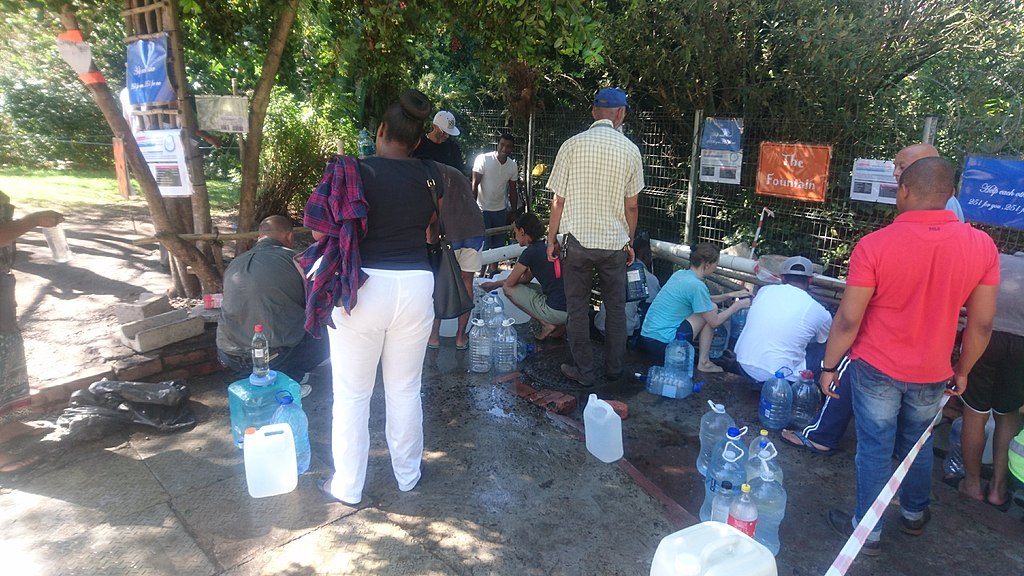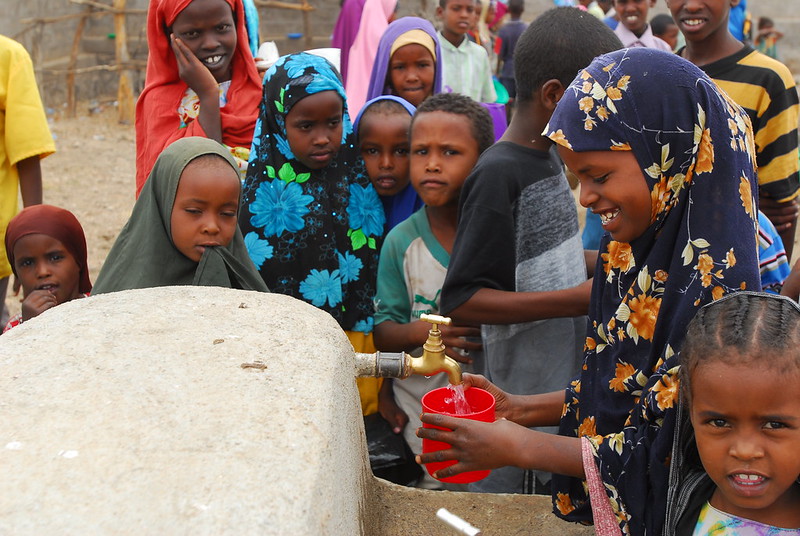From 2017 to 2018, the city of Cape Town in South Africa was in the throes of a drought so severe that authorities thought the city would completely run out of water, a day they had ominously dubbed “Day Zero.” The water levels of Cape Town’s major supply dams, which are sourced by rainfall, plunged. The city experienced its driest year on record in 2017, following extremely low rainfall in 2015 and 2016, but it wasn’t until mid-February of 2018 when the national government, the African National Congress, declared the ongoing drought a national disaster in the Western Cape and two neighbouring provinces, despite repeated calls from local officials to do so in order to release emergency relief funding. The slow response from the national government was partly due to a deficit in the water and sanitation department, which had overspent on its budget by USD$9.3 million and had no funds allocated for drought relief in the 2017-2018 financial year, exacerbating the water crisis. Meanwhile, the provincial government was experiencing infighting, its leader Patricia De Lille accused of corruption and maladministration. At one point, the military was prepared to be brought in to secure water distribution points, as there were concerns that violent clashes over resources would ensue. The water crisis had led to a political crisis, or was it the other way around?
The drought shone a light on the vast inequality in the city, where townships lie alongside wealthy, luxurious neighbourhoods. About 25% of Cape Town’s population resides in informal settlements, and get their water from communal taps rather than individual faucets at home. There are many examples throughout history of how political maladministration, corruption and simple lack of political will lead to water shortages. These shortages lead to more political strife and can culminate in full-on civil war, as seen in Syria in 2011.
—
Cape Town is not alone in its water woes, but is an indication of how the commodity will constrain global cities in the not-so-distant future and how the climate crisis will bring new challenges to areas already affected by class and racial divides. Day Zero never came for Cape Town, but it will for many global cities, and it will threaten democracy and social order.
As part of its plan to save water, and push back the dreaded Day Zero, Cape Town implemented restrictions that got increasingly severe. Level 4 restrictions implemented in May 2017 imposed an overall consumption limit of 100 liters per person per day, prohibited irrigation with drinking water and discouraged or banned other types of recreational water use. Level 4b restrictions, implemented the next July, tightened this limit to 87 liters per person per day, advising residents to cut showers to two minutes and reusing shower water to flush toilets. In January 2018, Level 6b restrictions were imposed, the harshest yet- residents’ daily usage was to be limited to 50 liters per day and agricultural use of water was slashed by 60% from the previous year. This is the absolute minimum amount to survive, as stated in a 1996 paper published by Peter Gleick, and to halt the spread of infectious diseases. In 2018, the average American consumed at least 330 liters a day, according to the US’ Environmental Protection Agency.
Water hoggers were also named and shamed, a typical technique used in times of crises; in fact, a coalition of citizens and activists protested Day Zero as propaganda used to cover up poor city water management. An op-ed written by the Water Crisis Coalition shortly after the 50-liter limit was passed says, “The purpose of all this (mis)information is clear: shifting blame from government. In fact, all tiers of Government is complicit through lack of foresight and mismanagement of our water resources.” Unfortunately, the technique worked- wealthy suburbs pointed fingers at the mostly-black and poor residents of the informal settlements- despite the fact that these settlements use the least water per capita of any place in the province- and residents of the informal settlements blamed the wealthy. Sure, blame on the government was doled out plentifully, but the water crisis largely turned into a battle between the haves and the have-nots.
This inequity was always there- stemming from the years of Apartheid that left black citizens with little resources; in 2014, an investigation into water access by the South African Human Rights Commission outlined the problem in Cape Town. “Those areas which lack water and sanitation mirror apartheid spatial geography,” the commission’s findings read. Even the built water infrastructure is based on exclusion.
The commission also found that four factors predict water protests: economic disparities and marginalisation, water-delivery problems, poor communication between authorities and the people and the presence of active and latest organising efforts and structures.

71% of Earth is covered with water. Less than 2% of that water is fresh, but only 1% of this is accessible, the rest trapped mostly in glaciers. This means that 0.007% of the planet’s water is available for us to use. This sounds scary, but this 0.007% should be more than enough for the planet’s inhabitants, and for as many as nine billion people, perhaps more.
The planet shouldn’t be having a water crisis, but through government neglect and indifference, poor infrastructure, contamination and careless urbanisation and development, we are having one, and we aren’t doing much about it. An analysis on freshwater in David Wallace-Wells’ book “An Uninhabitable Earth” finds that as much as 16% of freshwater in the US is lost through leaks or theft; in Brazil, this is as high as 40%. This will only serve to deepen the inequalities that exist in countries (the US has the highest income inequality of all G7 nations and in Brazil, the richest 10% accounted for 61% of economic growth from 2001 to 2015). So concerning is the impending water crisis that the “strategic natural resource” may become the “next oil.”
Another example of a water crisis caused by government ineptitude can be seen in Flint in Michigan in the US. In 2013, the city of Flint decided to use the nearby Flint River as a water source in a bid to save $5 million in two years. However, within months of the switch, fecal coliform bacteria was found in the water. The city ignored the claims and continued to tell the residents that their water was safe. They revised their stance as public concern grew, telling residents to boil their water and promising to increase levels of chlorine in the water. Shortly after, General Motors, the city’s largest employer, stopped using public water because the excess chlorine was corroding engine parts. The city continued to ignore the quality of the water. Eventually, residents started to complain about the metallic taste of the water and strange sicknesses. The chlorine had corroded lead pipes, which resulted in lead from the pipes leaching into the water. Still, the city ignored the problem. Three years later, lead and trihalomethane, a known carcinogen, still contaminate the water at levels nearly five times the acceptable limit.
The failure of the government to act in Flint could lie in politicians fearing for their political career being compromised if they speak out against the powers that be; re-election becomes more important than serving the people. Nobody wins in this scenario; had the city admitted fault and switched back to Detroit water when the bacteria was found, the water crisis (and the national outrage) could have been avoided completely.
You might also like: Report Highlights Climate Inequality: Richest 1% Cause Double the Emissions of Poorest 50%
In 2018, Peter Gleick of the Pacific Institute compiled a list of all armed conflicts related to water issues, beginning in 3 000 BC with the Sumeria legend of Ea. The list is made up of 500 water-related conflicts since 1900; almost half of these occurring since just 2010. A notable example includes the 2011-2012 drought in Syria that forced more than 1.5 million people, mostly farmers and their families, to move to cities. Political unrest began in March 2011 in Dara’a which soon escalated to civil war as ousters sought to overturn the regime of President Bashar al-Assad and the ruling Ba’ath Party. Another lies in Yemen, where a war has been going on since 2015 that has seen widespread damage to water infrastructure result in over 1.3 million cases of cholera, one of the worst cholera epidemics in recent history. Coupled with the COVID-19 pandemic that has seen potentially thousands of people avoiding seeking treatment in hospitals due to fear of contracting the virus, a humanitarian crisis is unfolding before our eyes, made worse through poor water supply.
Another complex humanitarian crisis has been seen in Chad since the 1970s, exacerbated by water shortages and famine. The African nation recently asked UNESCO to suspend an application for world heritage site status for Lake Chad so that it can explore oil and mining opportunities in the region. Lake Chad is host to one of the world’s most complex humanitarian crises, triggered by the climate crisis, religious extremism, population displacement and military operations, among other factors. About 45 million people live off the lake’s resources, and drilling for oil in such an unstable environment could spark insurgent attacks and oil spills polluting waters.
In the 1970s, the lake started to recede because of a drought; by the end of the 1990s, it had shrunk to roughly 2 000 sq km, a 95% decline from its peak, causing famine. However, in recent years, the area has rebounded to 17 000 sq km, putting the region in a precarious situation as government leaders may think the area is now “safe” from receding again.
Additionally and as briefly mentioned above, according to the US’ Centers for Disease Control and Prevention (CDC), droughts may lead to increases in infectious disease. Viruses, protozoa and bacteria can pollute both groundwater and surface water when rainfall decreases. Respiratory and gastrointestinal illnesses are more easily spread between people when a lack of available water restricts hand washing. E. coli and Salmonella are examples of bacteria that can more easily contaminate food and cause infectious disease during drought. Water shortages can also cause farmers to use recycled water to irrigate their fields; when used to grow crops, improperly treated water can cause a host of infectious diseases (such as those caused by toxin-producing E. coli and Salmonella), which can be life-threatening for people in high-risk groups. In addition, the likelihood of surface runoff, which can occur when rain fails to penetrate the dry and compacted soil that often accompanies drought, can contaminate crops.
Without any meaningful adaptation measures in distributing water resources in a warming world, the World Bank estimates that regional GDP could decline by as much as 14% in the Middle East, 12% in Africa’s Sahel, 11% in central Asia and 7% in east Asia- simply due to water insecurity.
According to Wallace-Wells, this year could see as many as 250 million Africans facing water shortages; by the 2050s, the number could hit a billion people in Asia alone. By this same time period, the World Bank estimates that freshwater availability in cities around the world could decline by as much as two-thirds. Overall, according to the UN, five billion people could have poor access to freshwater by 2050, nearly half of the estimated 9.8 billion global population by that time.
We can espouse the importance of individual conservation of water through all the PSAs and naming and shaming that we want but globally, between 70% and 80% of freshwater is used for agriculture, while an additional 10% to 20% is used for industry. In the wake of an impending global water crisis, every government needs to evaluate its farming practices and formulate long-term solutions such as large-scale desalination (however there are doubts about scalability) and wastewater recycling facilities. The fate of humanity quite literally depends on it.
Featured image by: UNICEF Ethiopia

















